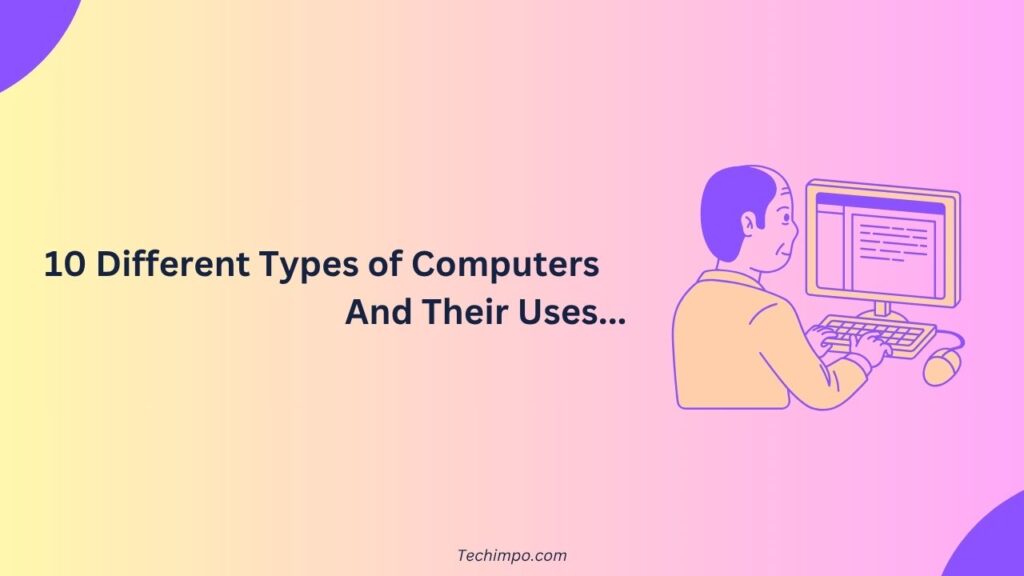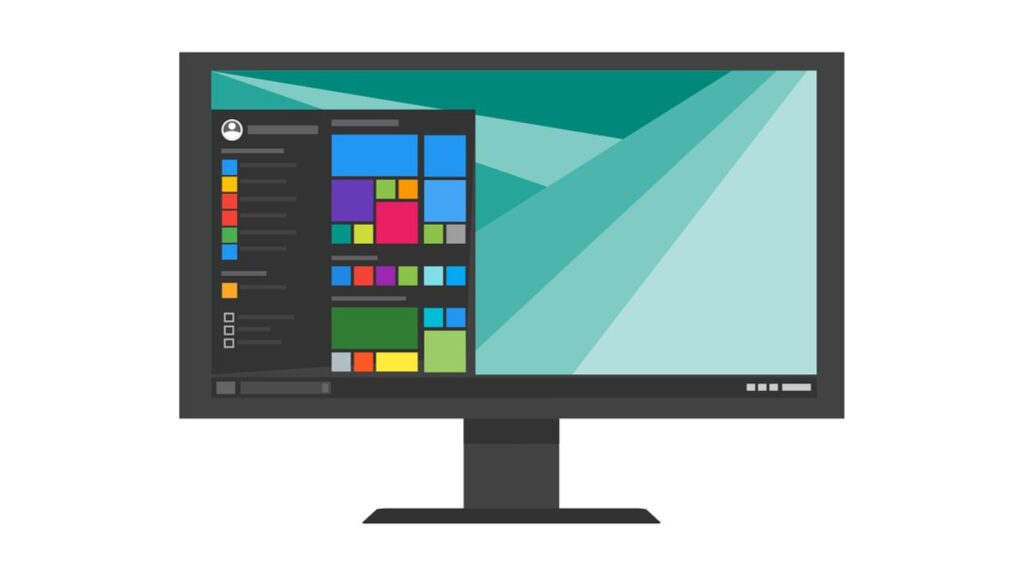In today’s technological world, computers are used everywhere. From simple tasks to complex projects, we are using these devices at almost every step needed to accomplish something. The prevalence of computers at such a large scale makes it essential to learn about their various types.
No device is an all-rounder. So it’s never possible to handle all kinds of tasks with a single type of computer. Keeping these facts in mind, the tech world has introduced various types of these machines, each one serving a specific set of purposes.
Below in this article, we have listed and explained 10 types of computers and their examples, along with their various uses. The knowledge of the different types of computers and their uses will help you understand which kind of machine will be suitable for a specific task to be performed.
Different Types of Computers and Examples
1) Microcomputer
Small computers like personal computers come under the category of minicomputers. These devices are meant to be used in schools or at home. They are user-friendly and affordable in price.
With the use of minicomputers, you can browse the internet, play games, manage emails, run some applications, and handle many types of small tasks. As they are small in size, they offer comfort and convenience in use. The computing speed of PCs can be as high as millions of instructions per second.
The speed of these machines is sufficient to handle scientific computing and processing of data, making them suitable for scientific research and production.
2) Minicomputer
Devices like Data General Nova and PDP-11 come under this category of computers. Minicomputers are medium in size, or in other words, their size is bigger than that of microcomputers.
This type of computer can be used by many people simultaneously (multi-user computer). And, as far as their pricing is concerned, they are not expensive. Minicomputers are used in universities, factories for the control of manufacturing processes, research institutions for data processing, hospitals, telecommunications management, etc.
Being simple in terms of structure, these machines can be easily maintained. However, they are more powerful if compared with microcomputers and less powerful if compared with mainframes.
The multiple processors that these computers come with are the reason behind their capability to allow multitasking and multiple users at the same time.
3) Mainframe
Mainframes are super powerful or high-performance computers that can process a huge amount of data at a time and can allow a large number of users at a time. Such powerful devices are seen being used in places like airports, banks, Insurance companies, large corporations, etc.
The computers like Unisys ClearPath, IBM Z-series, etc, come under the category of this type of computing system. The computing speed of mainframes can be as high as MIPS (millions of instructions per second).
Though these computers are more expensive, they are more secure and reliable. And, if we talk about their physical size, they are larger. They are built with redundant components and specialized hardware.
4) Workstation Computer
These computers are more powerful than usual computers. They are fast in processing and used for some special tasks. These machines come with good graphics and large memories.
They are high-end PCs usually with large-screen displays. So they can run multitasking programs and handle intensive requests with their powerful CPUs. HP Z Series and Dell Precision are two of the many examples of workstation computers.
With the use of workstation computers, you can comfortably perform tasks like creating designs, making models, editing videos, producing animations, developing games, developing software, etc. They are also used by scientists to conduct various experiments and to study scientific data.
5) Supercomputer
The next one of the 10 different types of computers is the supercomputer. These computers are used in fields such as fluid dynamics, climate research, weather forecasting, engineering, theoretical astrophysics, drug discovery, nuclear simulations, artificial intelligence, etc, as they can easily handle intense numerical calculations.
Supercomputers are considered to be the most powerful kind of computers. They are stronger and faster than all other types of computers. However, they are also larger and more expensive.
These computers feature big storage capacity, multiple CPUs, and speedy input-output capacities. They put into use parallel processing to handle complex computations. And, as far as their processing power is concerned, they can perform 1 quintillion calculations/second.
Cray XC40 and IBM Summit are some examples of supercomputers.
6) Server
Server computers are the type of computers that not only store data but also share it with other computers. These machines are quite powerful and possess a large storage capacity.
It is through these servers that sending and receiving emails become possible. They are also used for websites. With their powerful processors and huge amounts of memory, these machines are optimized to serve other computers connected to them via a network.
Servers offer high-speed computing with reliable operation. Redundant cooling, RAID, redundant cooling, etc, are some of its key features. We can further subdivide server computers into file server, database server, FTP server, Web server, etc.
HP ProLiant and Dell PowerEdge are two examples of this type of computer.
7) Laptop
In the past, if someone needed to use a personal computer, there was no other option to go for than a desktop. But in the mid-1980s, laptop computers were made popular by many computer manufacturers.
Devices like Dell Inspiron, etc, come under the category of laptops. They are small machines that you can take anywhere to use, as they are portable.
A laptop is battery-powered and features a built-in keyboard, display, trackball or pointing device, memory, processor, hard drive, etc. You can use it to browse the internet, type documents, do remote work, do online learning, and watch videos. It’s good for travel computing.
8) Handheld Computer
Devices like smartphones are examples of handheld computers. That’s because they are so small in size that they can be held in the hands and carried around comfortably. These devices have considerable processing power and can be easily accommodated in the pockets of your pants.
Another type of such portable computing devices is the personal digital assistant (PDA), which has lost its popularity with the rise of smartphones. This computing device combines computing, organizational features, and communication.
The extra functionality and versatility that smartphones these days are offering is considered to be the prime reason behind why PDA’s have been hugely replaced by them.
9) Notebooks and Tablets
Another important type of computer includes notebooks & tablets. Notebooks are portable computing devices that are smaller in size than laptops. They are cheaper in price if we compare them with regular computers. You can easily buy a notebook with a budget of just $200-$250.
Notebooks have small displays and less storage capacity, but you can use them to perform tasks such as browsing the internet, checking emails, streaming movies, using web-based apps, etc.
Tablets, on the other hand, are flat and thin devices that look like smartphones but seem to be their larger versions. Tablets have less storage capacity and lower processing power compared to traditional regular computers, but the plus point is that they are easily portable, and the battery life is also longer.
You can use tablets to browse the internet, read ebooks, play games, make drawings, take pictures, watch videos, etc.
10) Wearables
These are the devices that you can wear like watches, and they offer general computing functionalities. Wearables feature multimedia, emails, calendar, database, etc. Yes, all these common apps are integrated into a watch that you can wear on your wrist.
Personal computing has been revolutionized with the introduction of wearables. The Samsung Galaxy and the Apple Watch are examples of such wearables.
Conclusion
Every type of computer is designed to meet specific requirements, and each one plays a crucial role in different fields of our lives. As we grow more in tech, computers will evolve too, and we may have even more specialized types of these machines in the future.
Having a sound understanding of different types of computers and their uses makes us grateful for the versatility these machines offer. We hope the above guide helped you understand these types in detail.
[Also Read: Full Form of Computer and Other Related Full Forms]




